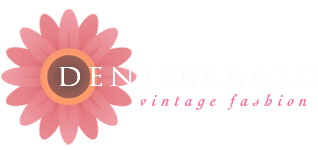I’ve decided to show two fabrics from the VFG Fabric Resource today, because so often these fabrics are confused with one other. They are indeed similar, both woven on a jacquard loom.
Brocade
An elaborately-patterned fabric woven on a jacquard loom since the early 19th century, brocade uses color, texture or both to emphasize its figures. The figures and ground may be of contrasting weaves such as satin on plain weave. Brocade is not considered reversible; the reverse is often distinguished by long floating threads.
Brocade was originally made in Asia, of silk with gold or silver threads, and it may still be silk or a manufactured filament fiber with metallic threads. The original looming was done manually.
Uses: Evening wear, accessories, household items
See also:
Brocatelle
Damask (below)
©Vintage Fashion Guild - Text by Margaret Wilds/denisebrain, photo by Hoyt Carter
 |
| 50s brocade shoes in my Etsy shop |
Damask
Damask differs from its jacquard relative brocade in that it can be reversed, although the reverse will feature the woven-in pattern in “negative.” Damask is characteristically one color but two different weaves, to set the patterns apart from the ground. If the pattern is satin on the face, it will be dull on the reverse. If two colors are used, these will be reversed on the back of the fabric.
The fabric gets its name from Damascus, Syria, a trade hub where this silk fabric from China was introduced to Europe. Starting in the 15th century, European damasks were made of linen; both staple fiber and filament fiber damasks are made still. Table linens of cotton and blends are often damask.
Uses: Table linens, household decorations, towels, wraps, evening wear, accessories
See also:
Brocade (above)
Jacquard, woven
©Vintage Fashion Guild - Text by Margaret Wilds/denisebrain, photo by Hoyt Carter
 |
| 60s silver damask dress in my Etsy shop |




